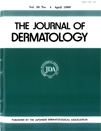Alteration of Skin Protein Kinase C α Protein and mRNA Levels during Induced Mouse Hair Growth
Abstract
Protein kinase C (PKC) has been implicated in regulation of hair growth. In this study, the role of PKC α in induced mouse hair growth was studied. Hair growth in C57BL6 mice, a well known model for hair growth research, was induced by plucking the telogen hair. PKC α protein levels during the induced hair growth cycle were analyzed by Western immunoblot and mRNA levels were measured by RT-PCR. At 1 day and 4 days postdepilation, when the induced hair cycle was in early and midanagen, the PKC α protein level was decreased. At 10 days after depilation, when the induced hair cycle was in mature anagen, the PKC α protein level was increased. At 17 days after plucking the hair, when the induced hair cycle was in early catagen, PKC α protein returned to the control level. PKC α mRNA was relatively unchanged at 1 day and 4 days after plucking the hair but significantly elevated at 10 days postdepilation. At 17 days after hair growth induction, PKC α mRNA reverted to the control level. These results suggest that: 1) in early and mid anagen of the induced hair growth cycle, PKC α was downregulated posttranscriptionally. This downregulation may play a role in the induction of hair growth; 2) in mature anagen of induced hair growth cycle, PKC α was overexpressed, and this overexpression may play a part in maintaining the hair growth. Since the expression of PKC α was roughy correlated with mouse skin pigmentation, we hypothesize that PKC α may regulate hair growth partially through modulation of skin melanogenesis.




